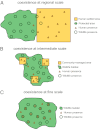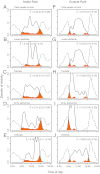Coexistence between wildlife and humans at fine spatial scales
- PMID: 22949642
- PMCID: PMC3458348
- DOI: 10.1073/pnas.1210490109
Coexistence between wildlife and humans at fine spatial scales
Abstract
Many wildlife species face imminent extinction because of human impacts, and therefore, a prevailing belief is that some wildlife species, particularly large carnivores and ungulates, cannot coexist with people at fine spatial scales (i.e., cannot regularly use the exact same point locations). This belief provides rationale for various conservation programs, such as resettling human communities outside protected areas. However, quantitative information on the capacity and mechanisms for wildlife to coexist with humans at fine spatial scales is scarce. Such information is vital, because the world is becoming increasingly crowded. Here, we provide empirical information about the capacity and mechanisms for tigers (a globally endangered species) to coexist with humans at fine spatial scales inside and outside Nepal's Chitwan National Park, a flagship protected area for imperiled wildlife. Information obtained from field cameras in 2010 and 2011 indicated that human presence (i.e., people on foot and vehicles) was ubiquitous and abundant throughout the study site; however, tiger density was also high. Surprisingly, even at a fine spatial scale (i.e., camera locations), tigers spatially overlapped with people on foot and vehicles in both years. However, in both years, tigers offset their temporal activity patterns to be much less active during the day when human activity peaked. In addition to temporal displacement, tiger-human coexistence was likely enhanced by abundant tiger prey and low levels of tiger poaching. Incorporating fine-scale spatial and temporal activity patterns into conservation plans can help address a major global challenge-meeting human needs while sustaining wildlife.
Conflict of interest statement
The authors declare no conflict of interest.
Figures



 (from zero [no overlap] to one [complete overlap]), is indicated by the orange area, and it is shown in each panel. Overlap was defined as the area under the curve formed by taking the minimum of the two activity patterns at each point in time. Approximate 95% bootstrap CIs of overlap estimates are indicated in parentheses. Average time of sunrise was 0600 hours, and average time of sunset was 1800 hours during the study.
(from zero [no overlap] to one [complete overlap]), is indicated by the orange area, and it is shown in each panel. Overlap was defined as the area under the curve formed by taking the minimum of the two activity patterns at each point in time. Approximate 95% bootstrap CIs of overlap estimates are indicated in parentheses. Average time of sunrise was 0600 hours, and average time of sunset was 1800 hours during the study.Comment in
-
Conflating "co-occurrence" with "coexistence".Proc Natl Acad Sci U S A. 2013 Jan 8;110(2):E109. doi: 10.1073/pnas.1217001110. Epub 2013 Jan 2. Proc Natl Acad Sci U S A. 2013. PMID: 23284175 Free PMC article. No abstract available.
-
Sinks as saviors: why flawed inference cannot assist tiger recovery.Proc Natl Acad Sci U S A. 2013 Jan 8;110(2):E110. doi: 10.1073/pnas.1216623110. Epub 2013 Jan 2. Proc Natl Acad Sci U S A. 2013. PMID: 23284176 Free PMC article. No abstract available.
-
Conflict of human-wildlife coexistence.Proc Natl Acad Sci U S A. 2013 Jan 8;110(2):E108. doi: 10.1073/pnas.1215758110. Epub 2013 Jan 2. Proc Natl Acad Sci U S A. 2013. PMID: 23284177 Free PMC article. No abstract available.
-
Reply to Goswami et al., Harihar et al., and Karanth et al.: Fine-scale interactions between tigers and people.Proc Natl Acad Sci U S A. 2013 Jan 8;110(2):E111-2. doi: 10.1073/pnas.1217414110. Proc Natl Acad Sci U S A. 2013. PMID: 23418643 Free PMC article. No abstract available.
References
-
- Woodroffe R, Thirgood S, Rabinowitz A. People and Wildlife: Conflict or Coexistence? New York: Cambridge Univ Press; 2005.
-
- Dudley N. Guidelines for Applying Protected Area Management Categories. Gland, Switzerland: International Union for Conservation of Nature; 2008.
Publication types
MeSH terms
LinkOut - more resources
Full Text Sources
Other Literature Sources

